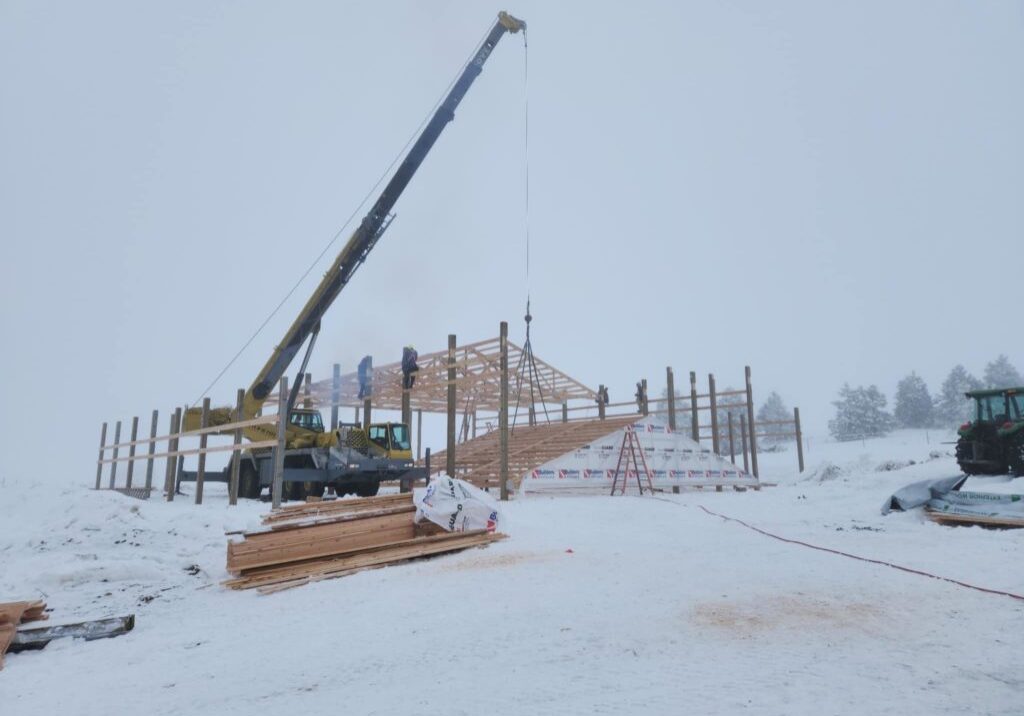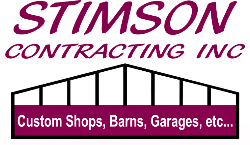
How Weather Affects Pole Barn Construction in the Northwest
As a builder who works throughout the Inland Northwest, I’ve learned one thing the hard way: weather matters. Especially when it comes to building pole barns. Whether you're constructing a shop, garage, barndominium, or storage barn, you can't ignore the impact of rain, snow, wind, and temperature swings that are typical in the Spokane region.
At Stimson Contracting, we’ve built through all four seasons and know what it takes to keep your pole barn project on track, no matter what the skies are doing. In this post, I’ll break down how the Northwest climate affects scheduling, materials, site prep, and design—and how we plan around it to deliver strong, durable buildings year-round.
Table of Contents
1. Why the Inland Northwest Climate Matters
Spokane and surrounding areas experience distinct seasons, each bringing its own set of construction challenges. From freezing winters to dry, hot summers and everything in between, building here requires planning around weather windows—especially for post-frame construction.
2. Winter Challenges: Snow, Frost, and Freezing Ground
In winter, frozen ground can delay excavation and make post setting nearly impossible without special equipment. Snow accumulation slows down framing and roofing, and icy conditions create safety hazards.
What we do:
Pre-pour foundation slabs before deep winter hits
Use frost sleeves or thermal protection where needed
Secure tarps and heat sources for work during short daylight hours
3. Spring Conditions: Mud and Drainage Issues
Spring may seem like a fresh start, but melting snow and heavy rain can turn job sites into mud pits. Soft soil can make equipment access difficult and delay critical steps like concrete work or grading.
Our solution:
Improve drainage early in the design
Elevate building pads for flood prevention
Use gravel and geo-fabric for stable access routes
4. Summer: Ideal for Speed, But Not Without Hazards
Summer brings long days, warm temps, and ideal conditions for most construction tasks—but it’s not perfect. Heat waves, wildfires, and material expansion are real concerns.
We mitigate by:
Scheduling early-morning work during heat waves
Choosing materials that perform well in thermal cycles
Monitoring fire risk during framing and welding tasks
5. Fall: Tight Windows and Shifting Weather
Fall is a great time to build—if you move fast. As temperatures drop and rain returns, we face:
Shortening daylight hours
Unpredictable wind and storm fronts
Tight schedules to finish exterior work before freeze-up
We recommend starting fall builds no later than early September to stay ahead of weather changes.
6. Moisture and Material Storage
Wet weather can damage untreated materials and delay installation. That’s why we always:
Store lumber and metal under cover
Wrap packages in waterproof materials
Stage deliveries to avoid weather exposure
7. Post Setting and Ground Conditions
Post-frame buildings rely on solid footing. Waterlogged or frozen soil can make it difficult to set posts properly.
We often:
Use sonotubes or engineered piers in poor soils
Allow longer curing times for footings in cool temps
Set posts in gravel when appropriate for drainage
8. Metal Roofing and Wind Considerations
High wind and snow loads are common in the Northwest, so we take extra precautions:
Engineer trusses for regional wind and snow loads
Use anti-siphon and fastener-sealed metal roofing systems
Design for snow slide and ice dam prevention on sloped roofs
9. Weather-Resilient Design Choices
Some clients want a pole barn that can truly handle anything. We recommend:
Covered porches and overhangs for weather protection
Gutters and downspouts to manage runoff
High R-value insulation for energy savings in extreme temps
Designing for the elements gives you comfort, longevity, and peace of mind.
10. Conclusion: Build Smart, Build Seasonally
In the Northwest, weather can’t be ignored—it has to be planned for. Whether you're breaking ground in spring or finishing a project in late fall, the right strategies can make the difference between delays and a smooth build.
At Stimson Contracting, we don’t just build structures—we build solutions tailored to the realities of Spokane’s weather. From foundation to finish, we’ll help you choose the best time to build and the right materials to make your pole barn stand strong through every season.
📞 Call us today for a free build consultation
🌐 Visit our website to view seasonal project timelines
📧 Get a customized weather-aware project quote
Excerpt:
Thinking about building a pole barn in the Northwest? Learn how Spokane’s weather affects construction and what Stimson Contracting does to build strong, reliable structures year-round.
Meta Description:
How Weather Affects Pole Barn Construction in the Northwest – Discover how seasons, soil, and moisture influence pole building timelines and durability in Spokane with Stimson Contracting.
📞 Call today to schedule a free site consultation 509.244.2636
🌐 Visit our website for Spokane-specific building tips
📧 Request a custom quote and timeline
Read our other articles:
- Home Page
Barndominiums in Spokane: Trendy, Durable, and Affordable
10 Reasons Pole Buildings Are the Future of Rural Construction
How to Choose the Right Pole Barn Contractor
Top Pole Barn Design Ideas for 2025
How to Plan Your Dream Shop Construction Project
What You Need to Know Before Building a Pole Barn in Spokane
The Pros and Cons of Living in a Barndominium
Spokane Shop Construction: Local Regulations to Know
Custom Pole Buildings: Options That Add Value
From Barn to Barndo: The Transformation Process
Spokane’s Growing Demand for Custom Commercial Buildings
Common Mistakes to Avoid with Pole Building Projects
Is a Pole Building Right for Your Small Business?
Why Pole Barns Are Ideal for Rural Spokane Properties
Can a Pole Barn Increase Your Property Value in Spokane?
Multi-Use Shop Buildings: Storage, Work, and More
7 Creative Uses for Pole Barns in Spokane
Exploring the Cost Per Square Foot of Pole Barns
10 Barndominium Myths Debunked
Building a Shop on a Budget Without Cutting Corners
Navigating Commercial Building Codes in Spokane
Turning a Pole Barn into a Livable Space
The Complete Guide to Pole Building Construction in Spokane
What Is a Barndominium and Why Should You Build One?
Shop Construction Mistakes to Avoid
Cost Breakdown: Building a Barndominium in 2025
Post-Frame vs. Pole Barn: What’s the Difference?
Spokane Area Shop Construction: Timeline Expectations
What Makes a Barndominium So Cost-Effective?
Top 5 Mistakes to Avoid When Building a Pole Barn
Tips for Constructing a Durable Warehouse
How to Insulate Your Pole Barn for All-Season Use
Is a Barndominium Right for Your Family?
How Long Do Pole Buildings Last? Lifespan and Maintenance
How to Make Your Shop Energy Efficient
Upgrading Your Existing Pole Building
Barndominium Floor Plans That Maximize Space and Style
Adding Insulation to Pole Buildings: Pros and Cons
Durable Flooring Options for Shop Spaces
How to Prepare Your Spokane Property for Pole Barn Construction
The Evolution of Pole Barn Design: Modern Features to Consider
How to Design a Multi-Use Pole Barn That Works for You
Luxury Barndominiums: Yes, It’s a Thing
How to Prepare a Commercial Lot for Building
Must-Have Add-Ons for Your Pole Barn Project
Barndo vs Tiny Home: Which One Fits Your Lifestyle?
Modern Office Construction: Open Space vs. Private
How to Select the Right Commercial Builder
Building a Custom Barndominium: What to Expect
Energy-Efficient Pole Buildings: Is It Possible?
Storage Solutions Inside Your Workshop
Tips for Adding Electrical and Plumbing to Your Shop
How to Incorporate Rustic Charm into Your Barndo
Mixed-Use Commercial Buildings: What to Know
How Weather Affects Pole Barn Construction in the Northwest
How to Add a Workshop to Your Barndominium
Spokane Zoning Regulations for Barndominiums
Spokane Businesses Love These Commercial Floor Plans
Shop Buildings for Hobbyists: What to Include
Spokane Horse Barn Builders
Spokane Indoor Arena Builders
Spokane Agricultural Farm Buildings
Spokane Airplane Hangar Builders
Spokane Commercial Building Builder
Pole Building Contractors in Airway Heights, WA
Pole Building Contractors in Medical Lake, WA
